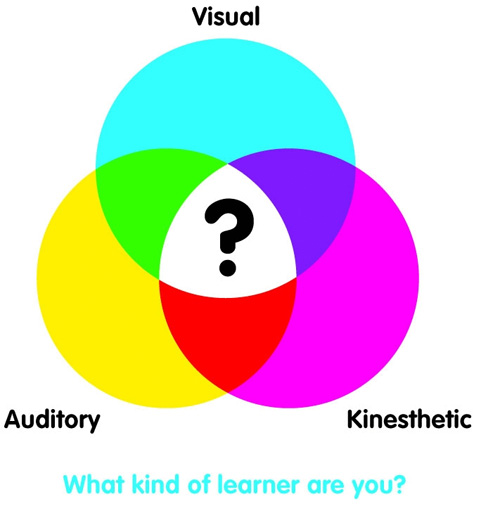I am fascinated by how people learn and spend a lot of time, perhaps too much, thinking about ways to enhance their learning experiences in my classes. There are many facets to the learning process. One of the simplest ways to make an improvement in your instruction and ability to communicate effectively is to consider your students’ learning styles. There are many models that purport to categorize, explain, and exploit the ways in which people learn new material. Most of them are rather arcane and debates abound in the academic community about their validity.
I have found that Fleming’s VAK/VARK model can translate into real world changes in my effectiveness as a teacher and coach. In this model learners are categorized into three groups:
Visual, in which ideas, concepts, data, and other information are associated with images
Auditory, in which a person learns through listening
Kinesthetic/Tactile, in which learners absorb information best by doing, experiencing, touching, moving, or being active in some way.
Most indoor cycling classes are structured around the concept of auditory learning. As instructors, we pay a lot of attention to the language that we use to cue certain events and describe the sensations that students will experience. Sometimes nothing we say seems to click, so we search for new ways to say the same thing. Did you ever consider that perhaps nothing you say will make a difference? By most estimates, auditory learners are only approximately 20%—30% of the population. Thus, while we must continue to refine our verbal cueing skills we must also find ways to make information accessible to the other learners in our classes.
Visual learners make up almost 60% of our classes. What changes can you make to your teaching style to meet their needs and enhance their learning? Here are some tricks that I use to ensure that I am addressing the needs of the visual learners.


Beverly, it is helpful to be reminded to use various methods of teaching to accommodate various styles of learning within a group. What about when you are working with an individual student? What do you look for to indicate what style of learning might be best for an individual student in a specific situation? Thanks for a good article.
Beverley – What a great idea to use laminated poster paper as a reusable writing surface. I’ll file that one away and am sure I will find myself in a situation where it will be the perfect solution.
Chris
I always post my ride profiles and in every class, no matter whether it’s my own or a sub, at least one rider will comment on how helpful it was to know what comes next in the ride. I use a laminated sheet of blank poster paper and dry erase markers. A spritz of alcohol and a paper towel restores the poster to white and I’m ready
for the next class.
Christine, this is the method of learning styles that I’ve always thought is the most effective in the indoor cycling studio. As a ski instructor, we were taught to use VAK when working with our ski students, and I have always found many similarities in getting information across to skiers, and cyclists, or really, any sport!